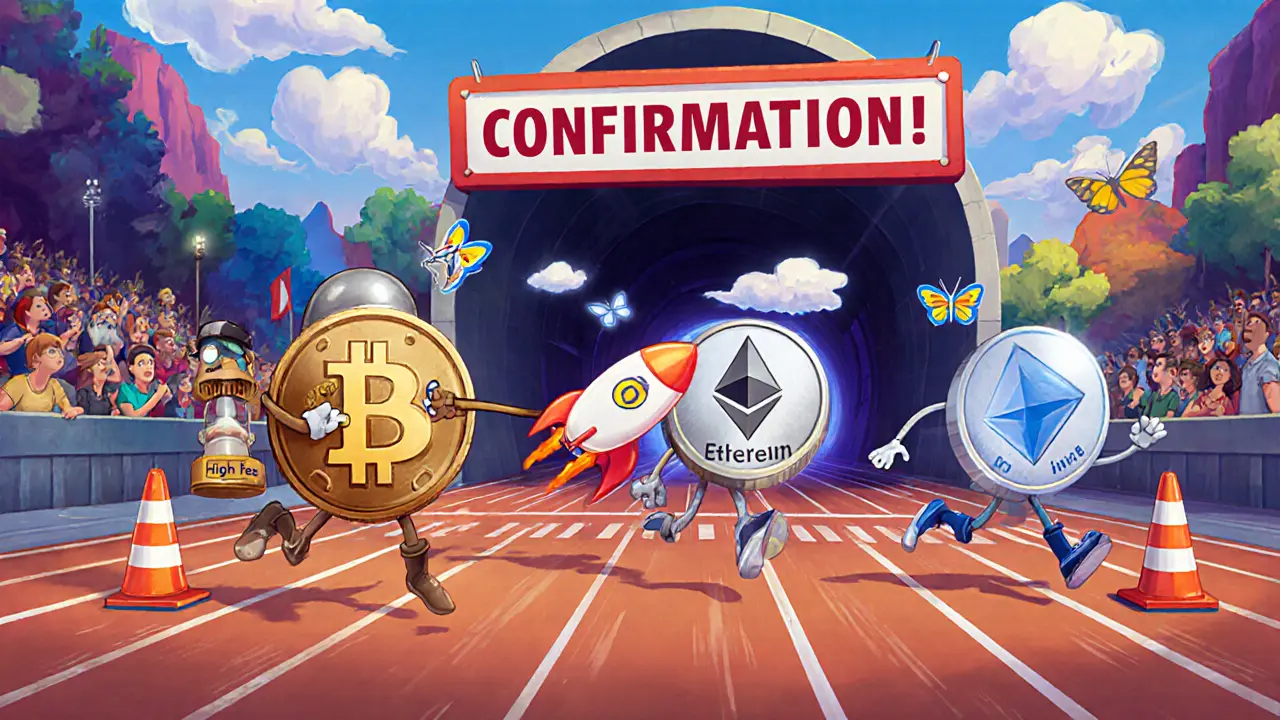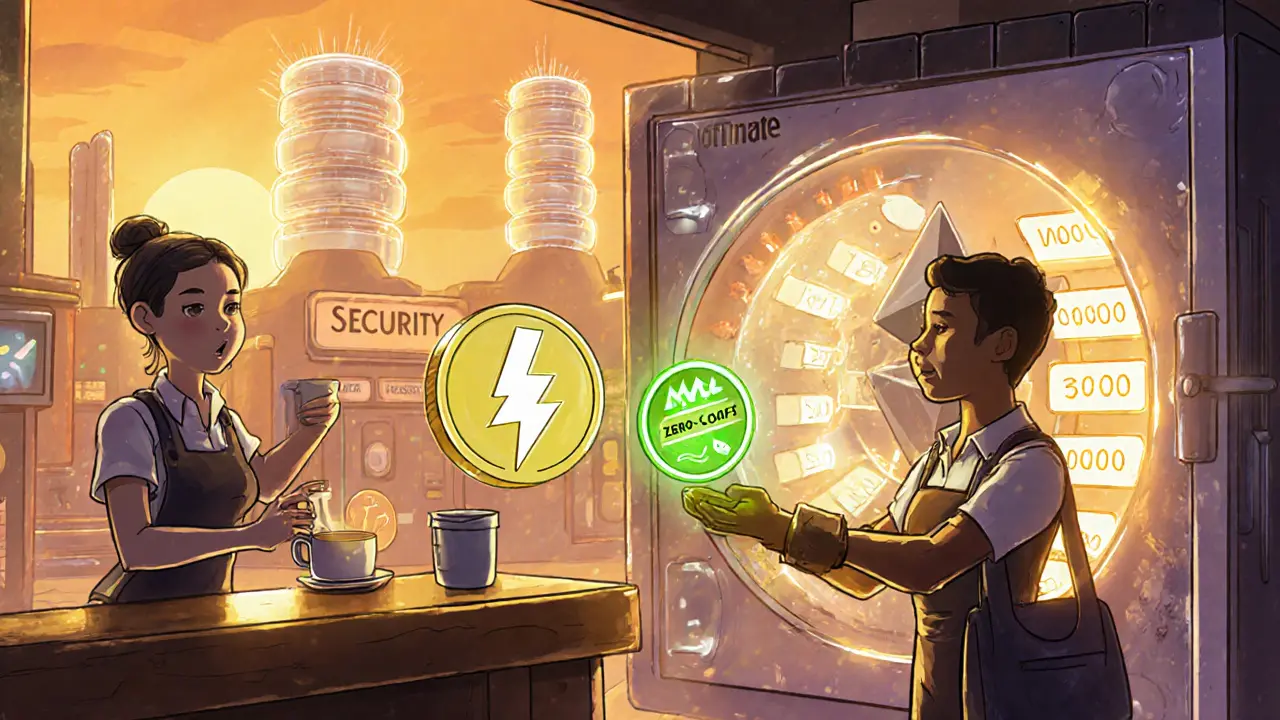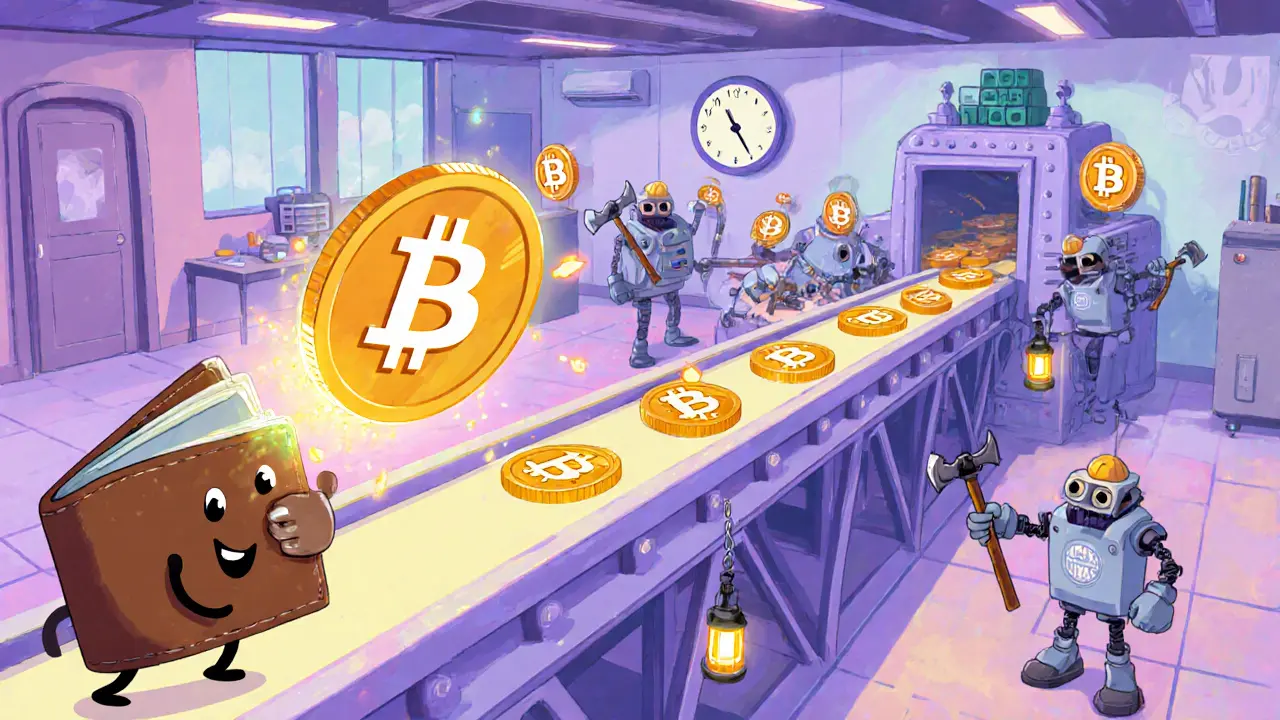Confirmation Time Estimator
Estimate how long your cryptocurrency transaction will take to confirm based on blockchain type, fee level, and network congestion.
Enter your selection to see estimated confirmation time
Key Takeaways
- Confirmation time is the gap between broadcasting a transaction and its inclusion in a block, plus any subsequent blocks.
- Higher transaction fees, low network congestion, and faster block times all shrink the wait.
- Bitcoin’s 10‑minute block time translates to about an hour for the commonly recommended six confirmations.
- Zero‑confirmation (Zeroconf) can give near‑instant receipt, but it carries higher double‑spend risk.
- Choosing the right number of confirmations balances speed against security for merchants and exchanges.
What is a cryptocurrency confirmation time?
Cryptocurrency confirmation time is the period from the moment a transaction is broadcast to the network until the moment it is recorded in a block that miners consider final. In plain English, it’s how long you wait before you can be fairly sure the money really moved.
Don’t mix it up with block time, which is the average time a network takes to mine a single block. Confirmation time includes the first block that contains your transaction and any additional blocks built on top of it. Each new block adds another layer of security, making it exponentially harder for an attacker to rewrite history.
How does a transaction move from ‘pending’ to ‘confirmed’?
The journey has three clear steps:
- Broadcast: Your wallet sends the transaction to peers. The data now lives in the mempool, a waiting room for unconfirmed transactions.
- Inclusion: A miner picks it up, bundles it with others, and mines a block. When the block is added, the transaction gets its first confirmation.
- Finality: Every subsequent block appended to the chain adds another confirmation. Most services consider a transaction “final” after a set number of these confirmations.
Because miners are profit‑driven, they prioritize transactions that pay higher fees. That’s why fee‑bumping can shave minutes-or even hours-off your wait.
Factors that stretch or shrink confirmation time
Several variables influence how fast a transaction confirms:
- Transaction fee: Higher fees = higher priority. Networks like Bitcoin use a fee‑per‑byte model, so larger transactions need proportionally higher fees.
- Network congestion: When many users are sending coins, the mempool fills up. Low‑fee transactions get stuck until the backlog clears.
- Block time: Bitcoin averages 10 minutes, but Ethereum targets ~12 seconds. Faster block times naturally reduce the raw confirmation window.
- Complexity of the transaction: Multi‑output or smart‑contract calls require more data, which can affect how quickly miners can fit them into a block.
- Consensus algorithm: Proof‑of‑Work (PoW) vs. Proof‑of‑Stake (PoS) designs have different latency. PoS chains often confirm within seconds.
Understanding these levers lets you fine‑tune your strategy-whether you’re a casual user or a merchant handling large volumes.

Bitcoin’s confirmation rhythm
Bitcoin is the poster child for confirmation time discussions because its 10‑minute block time is easy to grasp. Here’s a quick mental model:
- 1 confirmation ≈ 10 minutes
- 3 confirmations ≈ 30 minutes (common for moderate purchases)
- 6 confirmations ≈ 1 hour (widely accepted for larger sums)
- 60 confirmations ≈ 10 hours (used for very high‑value transfers)
Why the 6‑confirmation rule? Each new block lowers the odds of a successful double‑spend attack dramatically. After six blocks, the probability drops below 0.1 % under normal conditions, which most exchanges and merchants deem safe.
Zero‑confirmation (Zeroconf) - instant but risky
Zero‑confirmation transactions, often called Zero confirmation, skip the waiting game entirely. The transaction is broadcast, and the recipient treats it as “good enough” before a miner actually locks it into a block.
Why would anyone trust that?
- Speed: Payments settle in seconds, matching credit‑card experiences.
- Convenience: Ideal for point‑of‑sale (POS) systems where customers expect a swift checkout.
But the trade‑off is security. Without the backing of a mined block, a double‑spend attack is still possible, especially during network congestion or when fees are low. Services that accept Zeroconf usually impose caps (e.g., only for transactions under $100) and monitor the mempool for conflicting spends.
How many confirmations should you require?
The answer depends on three things: transaction value, risk tolerance, and the specific blockchain’s security model.
| Coin | Block time | Suggested confirmations for small payments | Suggested confirmations for large payments |
|---|---|---|---|
| Bitcoin | ≈10 min | 0‑3 | 6‑12 |
| Ethereum | ≈12 s | 0‑1 | 5‑10 |
| Litecoin | ≈2.5 min | 0‑2 | 4‑8 |
Remember, the numbers above are guidelines. A reputable exchange might ask for more confirmations during periods of high volatility or known attacks.

Practical tips to speed up confirmations
- Pay a competitive fee: Use fee estimators (e.g., mempool.space for Bitcoin) to see the current “fast” fee level.
- Choose a less congested time: Network activity fluctuates daily. Early mornings in UTC often see lighter loads.
- Leverage fee bumping: Some wallets support Replace‑by‑Fee (RBF), letting you raise the fee after broadcasting.
- Use faster chains for low‑value transfers: For micro‑payments, consider layer‑2 solutions like the Lightning Network or roll‑up chains on Ethereum.
- Set appropriate confirmation thresholds: Align your policy with transaction size. Small coffee purchases can settle on zero confirmation; large real‑estate transfers should wait for many confirmations.
Security implications of waiting for confirmations
Each additional block reduces the chance that an attacker can rewrite history. The math is simple: the probability of a successful double‑spend drops roughly by half with every new block added, assuming honest majority mining power.
For merchants, the cost of waiting (lost sales, angry customers) must be weighed against the risk of a reversal. Services that can absorb a small loss might opt for fewer confirmations, while high‑risk sectors (e.g., escrow services) prefer the safety net of many confirmations.
Future trends - will confirmation times keep dropping?
Several developments aim to shrink latency without compromising security:
- Ethereum 2.0 (Proof‑of‑Stake): Finality is expected within seconds thanks to the Casper finality gadget.
- Layer‑2 scaling: Networks like Lightning, Optimistic Rollups, and zk‑Rollups settle transactions off‑chain and anchor them to the main chain, delivering sub‑second finality.
- Improved mempool propagation: Faster gossip protocols reduce the time a transaction spends waiting to be seen by miners.
Until these solutions become mainstream, understanding the underlying mechanics of confirmation time remains essential for anyone handling crypto.
Next steps for crypto users and businesses
- Audit your current wallet or payment gateway: Does it expose fee estimates? Does it support RBF?
- Set a clear confirmation policy: Write it down, train your staff, and embed it into your checkout flow.
- Monitor network health: A quick glance at a block explorer can tell you if the mempool is swelling.
- Experiment with layer‑2 options for low‑value, high‑frequency payments.
What exactly is a ‘confirmation’ in crypto?
A confirmation occurs when a miner includes your transaction in a block that the network accepts as valid. Each new block added on top of that block counts as an additional confirmation.
Why does Bitcoin take about 10 minutes per confirmation?
Bitcoin uses a Proof‑of‑Work algorithm that adjusts difficulty so the average time to solve a block is roughly 10 minutes. This design balances security and decentralization.
Can I speed up a Bitcoin transaction after I send it?
If your wallet supports Replace‑by‑Fee (RBF), you can broadcast a replacement transaction with a higher fee. Otherwise, you’ll need to wait for the original transaction to either confirm or be dropped.
Is zero‑confirmation safe for online shopping?
Zero‑confirmation works for low‑value, low‑risk purchases where the merchant can absorb a potential double‑spend. For larger amounts, waiting for at least a few confirmations is advisable.
How do transaction fees affect confirmation time?
Miners prioritize transactions that pay higher fees per byte. Offering a fee above the network’s “fast” threshold dramatically reduces the waiting period.


Molly van der Schee
October 22, 2025 AT 10:07Understanding how confirmation times work really helps when you’re moving crypto around, especially if you’re trying to avoid unnecessary delays.
Higher fees usually push your transaction toward the front of the mempool, which can shave minutes off the wait.
For merchants, balancing speed and security often means picking a sensible number of confirmations based on the transaction size.
Keeping an eye on network congestion and using fee estimators are practical ways to stay ahead of the curve.
Erik Shear
October 24, 2025 AT 17:40You think fee bumping is a gimmick? No it works. Pay more and get fast confirmations.
Donnie Bolena
October 27, 2025 AT 01:14Wow!!! The way block times differ between Bitcoin and Ethereum is mind‑blowing!!!
Bitcoin’s ten‑minute rhythm feels ancient compared to Ethereum’s sub‑minute blocks!!!
When you add a higher fee, miners practically chase your transaction like a prize!!!
Zero‑confirmation sounds like magic but remember the double‑spend risk is real!!!
Layer‑2 solutions such as Lightning give near‑instant finality while keeping security!!!
All these levers together let you fine‑tune speed versus safety!!!
Elizabeth Chatwood
October 28, 2025 AT 18:54Thx for the breakdown. i kinda love the l2 stuff but still worry bout security
Lindsey Bird
October 31, 2025 AT 16:20The world of crypto confirmations feels like a high‑stakes thriller, each block a ticking clock that could change fortunes in an instant. Imagine waiting ten minutes for a single Bitcoin confirmation, heart pounding as the mempool swells like a stormy sea. Every extra block is a layer of armor, a promise that the transaction is locked away from the clutches of a double‑spend villain. Yet the patience required can feel like an eternity for a coffee purchase, a drama that tests the nerves of even the most seasoned traders. The fees rise like a dramatic crescendo, louder with each surge of congestion, demanding attention like a spotlight on a stage. When you finally see that green check, it’s a sigh of relief, a curtain falling on a tense act. But the story doesn’t end there; the specter of zero‑confirmation looms, seductive and dangerous, promising instant gratification at the cost of security. Merchants who gamble on it are like daredevils, balancing profit against the risk of a sudden reversal. The block time itself is a character, slow and deliberate in Bitcoin, swift and agile in Ethereum, each shaping the narrative in its own rhythm. Layer‑2 solutions enter the plot like secret passages, offering sub‑second finality while the main chain watches from the wings. Yet these shortcuts can hide hidden traps, requiring vigilant monitoring to avoid pitfalls. As network congestion spikes, the mempool becomes a bustling crowd, and your transaction may be left waiting like a forgotten line in a theater queue. Fee estimators act as the director’s cues, guiding you toward the “fast” lane with precise timing. The balance between speed and safety is the central theme, a moral dilemma that every user must resolve. In the end, understanding these levers transforms you from a passive audience into the protagonist of your own crypto saga.
john price
November 1, 2025 AT 20:07i think this whole confirmation hype is overblown but yea you cant ignore the math. the more blocks the less chance of an attack, thats just logic. if u want speed push fees hard!!!
Jenna Em
November 3, 2025 AT 05:27Fees decide how fast a crypto tx gets confirmed.
Stephen Rees
November 4, 2025 AT 03:40perhaps the network hides deeper reasons beyond mere fees.
Katheline Coleman
November 6, 2025 AT 11:14It is essential for financial institutions to adopt a systematic approach when determining the appropriate number of confirmations for each transaction. By conducting a thorough risk assessment, organizations can align their security thresholds with the value and volatility of the assets involved. Moreover, continuously monitoring mempool dynamics enables timely adjustments to fee strategies. Implementing such disciplined policies fosters both operational efficiency and mitigated exposure to double‑spend threats.
Amy Kember
November 7, 2025 AT 15:00Agreed formal policies are key but they must stay flexible to market shifts
Evan Holmes
November 9, 2025 AT 08:40Just another post about fees.
Scott McCalman
November 11, 2025 AT 16:14Listen up, everyone!!! This is the ultimate guide to crypto confirmation times, and if you’re still guessing about fees you’re living in the Stone Age 😎!!! Bitcoin’s ten‑minute blocks are like watching paint dry, while Ethereum’s twelve‑second cadence feels like a roller‑coaster ride!!! Zero‑confirmation might sound like a miracle, but it’s a ticking time bomb waiting to blow up your wallet!!! Trust the experts, use fee estimators, and never settle for “good enough”!!!
Andrew Smith
November 12, 2025 AT 17:14True, the details matter a lot, so bump those fees and keep transactions moving forward!
mike ballard
November 14, 2025 AT 19:14From a protocol‑level perspective, the latency introduced by consensus finality is directly proportional to block propagation latency and validator set turnover. Optimizing the gas price market dynamics can effectively reduce the mempool backlog, thereby decreasing time‑to‑finality. Implementing EIP‑1559 style fee mechanisms also aligns user incentives with network demand elasticity. In practice, adopting roll‑up solutions abstracts transaction finality to sub‑second intervals while preserving L1 security guarantees. Therefore, a multi‑layer architecture is the pragmatic path forward for high‑throughput applications.
Mike Cristobal
November 16, 2025 AT 01:47While the tech sounds impressive, we must remember that chasing speed should never eclipse the core principle of protecting users from fraud 😊.